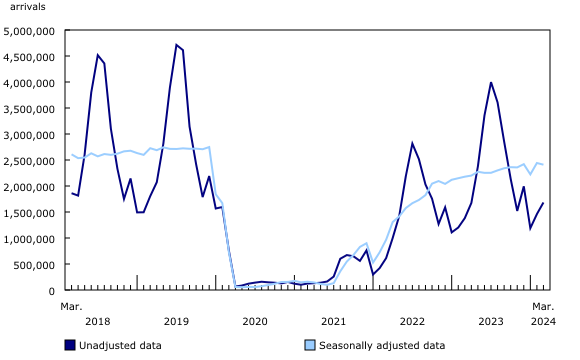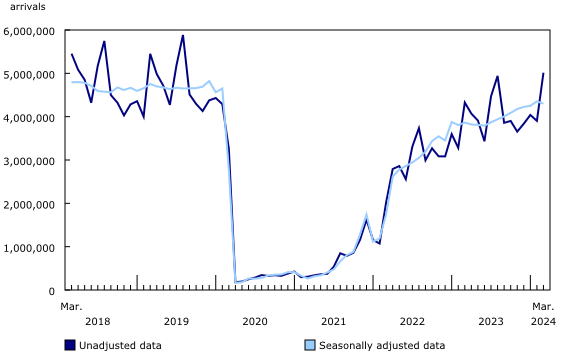Travel between Canada and other countries, March 2024
Released: 2024-05-23
Highlights
In March, the number of non-resident visitors to Canada accounted for 93.3% of the number observed in March 2019, before the COVID-19 pandemic. US residents took 1.3 million trips to Canada in March 2024 and residents of overseas countries embarked on 346,900 trips.
The number of returning Canadian residents reached 92.0% of the level recorded in March 2019 as Canadian residents returned from 5.0 million trips abroad in March 2024.
Using seasonally adjusted data, both the number of non-resident arrivals to Canada and returning Canadian-resident arrivals decreased 1.3% in March from February.
To further explore current and historical data in an interactive format, please visit the Frontier Counts: Interactive Dashboard.
Trips to Canada by US residents
In March, US residents took 1.3 million trips to Canada, up 22.1% from the 1.1 million trips taken during the same month in 2023 and reaching 91.7% of the level observed in March 2019 (1.5 million), pre-pandemic.
Almost three-quarters (72.3%) of US residents visiting Canada arrived by automobile (965,500 arrivals) in March 2024, and over half (53.1%) of those were same-day trips. Arrivals by automobile were up 23.9% year over year and represented 94.6% of such trips recorded in March 2019. US residents also took trips crossing over Canadian land borders in March 2024 by other means, such as by bus (27,300), as pedestrians (7,100), or by train (6,100).
Air arrivals (314,400) constituted 23.5% of all trips to Canada taken by US residents in March. Those arrivals were 14.3% higher than they were in the same month in 2023 and reached 85.7% of such trips taken in March 2019.
In March 2024, the points of entry most frequented by US residents entering Canada by automobile were near Vancouver (including Douglas and Pacific Highway in Surrey), near Niagara (including Niagara Falls and Fort Erie), and in Southwestern Ontario (including Windsor and Sarnia). Together, these were the points of entry for 72.2% of all such trips.
The busiest points of entry by air in March were in Toronto (including Toronto Pearson International Airport and Billy Bishop Toronto City Airport), Vancouver, Montréal, and Calgary. Combined, these points of entry represented 93.0% of all US-resident arrivals by air in Canada.
Trips to Canada by overseas residents
In March, 346,900 overseas residents arrived in Canada, an increase of 20.4% from the 288,200 overseas arrivals observed in March 2023 and slightly exceeding the 346,200 arrivals recorded in March 2019. Most (86.4%) of the overseas residents arriving in March 2024 flew into Canada (299,800 arrivals).
The top three countries overseas visitors to Canada resided in—the United Kingdom (40,500), Mexico (36,100), and India (28,100)—together represented nearly one-third (30.2%) of all overseas arrivals in Canada during March. Mexico dropped to second place after four consecutive months at the top of the list, possibly attributable to more restrictive visa requirements for Mexican nationals wishing to enter Canada. France was bumped to fourth place by India, which had not appeared in the top three since June 2023.
In March 2024, overseas residents arrived in Canada most frequently at airports located in Toronto, Vancouver, Montréal, and Calgary. Combined, these airports welcomed 96.2% of all overseas-resident arrivals by air.
Trips abroad by Canadian residents
Canadian residents returned from 5.0 million trips abroad in March, increasing 15.9% from March 2023 (4.3 million) and reaching 92.0% of such trips taken during the same month in 2019 (5.5 million).
In March 2024, Canadian residents flew back to Canada from 2.5 million trips abroad, which represented half (50.3%) of the total trips taken by Canadian residents. In March, the air arrivals were 9.5% higher compared with the same month a year earlier and reached 97.7% of such arrivals recorded in March 2019.
Trips to the United States by automobile (2.4 million) in March 2024 represented nearly half (48.5%) of the total trips taken by Canadian residents, and nearly two-thirds (62.3%) of those were same-day trips. Canadian residents returning by automobile from a visit to the United States increased by 23.1% year over year and represented 87.2% of such trips taken in March 2019.
In March 2024, the busiest airports for Canadian residents returning home from abroad were in Toronto, Vancouver, Montréal, and Calgary. Combined, these airports represented 87.2% of all air arrivals from the United States and 83.9% of all overseas air arrivals.
The busiest points of entry for Canadian residents returning from the United States by automobile in March were near Vancouver, in Southwestern Ontario, and near Niagara. These points of entry represented a combined 63.3% of such trips.
Seasonally adjusted arrivals
Tourism is influenced by seasonal effects (e.g., actual seasons and holidays such as Canada Day and Thanksgiving) and by calendar effects (e.g., number of weekends in a month). All statistics in this section are based on seasonally adjusted data (for more information, please see Note to readers).
In March, the number of arrivals in Canada by US residents decreased by 0.8% compared with February. This decrease was mostly attributable to the decline in the number of automobile trips from the United States (-2.9%), both same-day and overnight. While US-resident arrivals by air also decreased month over month (-0.5%), the number of US residents arriving in Canada by modes other than air and automobile (e.g., bus, ferry, and train) increased by 13.9%.
The number of overseas-resident arrivals in Canada decreased by 3.0% in March compared with the previous month. Arrivals by residents of Europe—the largest overseas market, with 42.9% of the total overseas arrivals—increased by 0.7%, bolstered by increased arrivals from France (+2.9%), Germany (+1.8%), and the United Kingdom (+1.0%). Arrivals in Canada by residents of Asia, the second-largest overseas market, decreased by 2.7% month over month. While India, the top Asian country in terms of the number of arrivals, increased by 10.1% in March, the number of visitors from China (-5.7%) and South Korea (-9.0%) decreased.
The Americas (excluding the United States) ranked as the third-largest overseas market, with 17.5% of the total overseas arrivals in March. This market decreased 15.1% from February, which can be attributed to a 43.8% decline in the number of arrivals from Mexico. Meanwhile, visitors arriving in Canada from South America increased 32.9% in March, driven by residents of Brazil (+49.9%).
Canadian residents returning from a trip abroad in March decreased 1.3% from February, ending the eight consecutive monthly increases of such trips. The decrease can be attributed to the 1.9% decline in the number of overnight trips by air—down 2.0% from the United States and down 1.8% from overseas countries. Meanwhile, Canadian residents taking trips to the United States by automobile decreased 1.2% from February, with same-day trips decreasing 2.2%.
Did you know we have a mobile app?
Download our mobile app and get timely access to data at your fingertips! The StatsCAN app is available for free on the App Store and on Google Play.
Note to readers
Beginning with the January 2024 release, seasonally adjusted data are used in The Daily release to allow for more accurate monthly comparisons.
What is seasonal adjustment? Tourism is influenced by seasonal and calendar effects. These effects can bring about changes in the data that normally occur at the same time, and in about the same magnitude, every year. A seasonally adjusted time series is a time series that has been adjusted to eliminate the effect of seasonal and calendar influences. Seasonally adjusted data allow for more meaningful comparisons of economic conditions from period to period. For information on seasonal adjustment, see Seasonally adjusted data – Frequently asked questions.
Seasonally adjusted data have been produced using the X12 ARIMA seasonal adjustment program.
Seasonally adjusted data for January 2023 to February 2024 have been revised. No revisions were made to unadjusted (raw) data.
Unless otherwise specified, this release uses unadjusted data.
Readers are encouraged to review the concepts, definitions, data sources, methods, and summary of changes for Frontier Counts, as well as explanatory notes for online tables, especially when making historical comparisons and examining specific regions.
For more current estimates of international arrivals to Canada, please see the "Leading indicator of international arrivals to Canada" for the April 2024 reference month.
For more information on travel by Canadian residents, please see the quarterly release of the National Travel Survey (NTS). For more information on travel in Canada by non-residents, please see the quarterly release of the Visitor Travel Survey (VTS). NTS and VTS data for the first quarter of 2024 will be available on August 28.
Products
The product "Frontier Counts: Interactive Dashboard," part of the Data Visualization Products series (71-607-X), is also available.
Contact information
For more information, or to enquire about the concepts, methods, or data quality of this release, contact us (toll-free 1-800-263-1136; 514-283-8300; infostats@statcan.gc.ca) or Media Relations (statcan.mediahotline-ligneinfomedias.statcan@statcan.gc.ca).
- Date modified:




